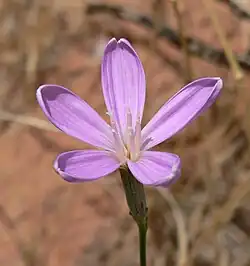Lygodesmia grandiflora
| Lygodesmia grandiflora | |
|---|---|

| |
| Lygodesmia grandiflora var. dianthopsis | |
| Scientific classification | |
| Kingdom: | Plantae |
| Clade: | Tracheophytes |
| Clade: | Angiosperms |
| Clade: | Eudicots |
| Clade: | Asterids |
| Order: | Asterales |
| Family: | Asteraceae |
| Genus: | Lygodesmia |
| Species: | L. grandiflora
|
| Binomial name | |
| Lygodesmia grandiflora (Nutt.) Torr. & A.Gray
| |
Lygodesmia grandiflora, the largeflower skeletonplant[1] or showy rushpink, is a perennial plant in the family Asteraceae found in the Colorado Plateau and Canyonlands region of the southwestern United States.[2]: 112
The plant grows up to 10–30 centimeters (4–12 in) tall.[3] Its stems are thin and flexuous. The narrow leaves are larger towards the base.[3] The stem bears one or sometimes a few flower heads, which have 6–15 pink to bluish rays about 4 cm (1+1⁄2 in) long.[3] Unusually for its family, it has no disc florets. It flowers early in summer.[3]
References
- ^ NRCS. "Lygodesmia grandiflora". PLANTS Database. United States Department of Agriculture (USDA). Retrieved 25 June 2015.
- ^ Canyon Country Wildflowers, Damian Fagan, 2nd ed., 2012, Morris Bush Publishing, LLC. in cooperation with Canyonlands Natural History Association, ISBN 978-0-7627-7013-7
- ^ a b c d Taylor, Ronald J. (1994) [1992]. Sagebrush Country: A Wildflower Sanctuary (rev. ed.). Missoula, MT: Mountain Press Pub. Co. p. 162. ISBN 0-87842-280-3. OCLC 25708726.
